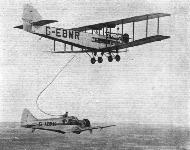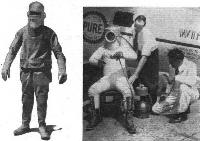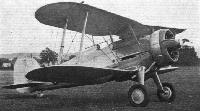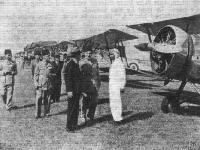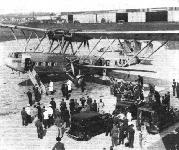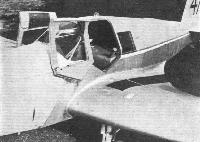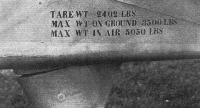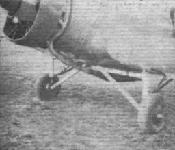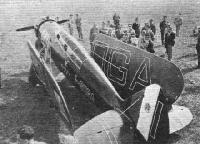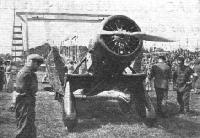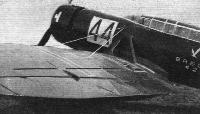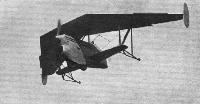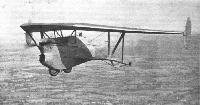Фотографии
-
WHAT FRANCE IS BUYING: The Dewoitine D-500 fighter (Hispano-Suiza 12 x brs 690 h.p. engine) which has been adopted by France as a standard military type. The very latest versions of the machine attain speeds round the 260 m.p.h. mark.
Самолёты на фотографии: Dewoitine D.500 / D.510 - Франция - 1932
-
Регистрационный номер: G-ACTE A FAST "HAWK": Built for Sir Charles Rose, this "Hawk," with a "Gipsy Six" 200 h.p. engine, has a top speed of about 180 m.p.h.
Самолёты на фотографии: Miles Hawk / M.2 - Великобритания - 1932
-
THE WINNING MACHINE: Bajan's R.W.D.9 (Polish Skoda engine) is fitted with Handley Page leading edge slots and slotted trailing edge flaps. A similar machine secured second place.
Самолёты на фотографии: RWD RWD-6 / RWD-9 / RWD-20 - Польша - 1932
-
GROOMING THE SKODA: Capt. Bajan watches his mount being overhauled.
Самолёты на фотографии: RWD RWD-6 / RWD-9 / RWD-20 - Польша - 1932
-
"THROUGH THE GATE": An R.W.D.-9.
Самолёты на фотографии: RWD RWD-6 / RWD-9 / RWD-20 - Польша - 1932
-
DURING THE WING-FOLDING TESTS: One of the R.W.D.-9's, with horizontal folding
Самолёты на фотографии: RWD RWD-6 / RWD-9 / RWD-20 - Польша - 1932
-
A POLISH DEFENDER: The RWD 9 has slotted flaps.
Самолёты на фотографии: RWD RWD-6 / RWD-9 / RWD-20 - Польша - 1932
-
OVER THE TAPE: Florjanowicz on an R.W.D.-9
Самолёты на фотографии: RWD RWD-6 / RWD-9 / RWD-20 - Польша - 1932
-
FANCY SKY EAGLES: A group of new high-speed, single-seater Boeing P-26A pursuit 'planes, attached to the 95th Pursuit Squadron, make a cross-country flight from March Field, California.
Самолёты на фотографии: Boeing P-26 Peashooter - США - 1932
-
Регистрационный номер: G-ABXN [2], G-EBMR PRACTICE MAKES PERFECT: Sir Alan Cobham carries out a refuelling test at Portsmouth in preparation for his forthcoming non-stop flight to India with Sqd. Ldr. Helmore in the Airspeed "Courier." The "tanker" seen above is Sir Alan's Handley Page W.10 (ex City of Pretoria of Imperial Airways).
Самолёты на фотографии: Airspeed Courier / AS.5 - Великобритания - 1933Handley Page H.P.18 (W.8) / H.P.30 (W.10) - Великобритания - 1919
-
THE SWEDISH TEAM: The Northrop "Delta" Holland, and its crew, M. Lindholm (left) and G. Lindow.
Самолёты на фотографии: Northrop Delta - США - 1933
-
Регистрационный номер: NR105W NOT A DEEP-SEA DIVER! We have already referred to the special flying suit which Wiley Post will wear for flights into the stratosphere. Above are two such suits, that on the right containing, in addition to air from the supercharger, Wiley Post himself.
Самолёты на фотографии: Lockheed Vega - США - 1927
-
GLOSTER P.V. F.7/30 FIGHTER (BRISTOL "MERCURY"): A formidable fighter armed with four machine guns, one on each side of the fuselage and one below each wing. The Dowty sprung wheels of the under-carriage are fitted each on a single cantilever strut.
Самолёты на фотографии: Gloster Gladiator - Великобритания - 1934
-
Регистрационный номер: EA-SCA COALS TO NEWCASTLE: One of the two Autogiros which are being delivered to Barcelona, Spain, for use in the Spanish Navy by pilots G. Guardia and A Guilian.
Самолёты на фотографии: Cierva/Avro C.30A / Rota - Великобритания - 1932
-
Регистрационный номер: G-ACXO No. 35: The Fairey "Fox" to be flown by R. Parer and G. E. Hemsworth.
Самолёты на фотографии: Fairey Fox - Великобритания - 1925
-
RECONNOITRING: A flight of No. 2 (Army Co-operation) Squadron flying over a camp in recent Army manoeuvres. The machines are Hawker "Audax" with Rolls-Royce "Kestrel." Working in a flight usually indicates that A.C. machines are on medium reconnaissance. Close reconnaissance is carried out by a single machine.
Самолёты на фотографии: Hawker Audax - Великобритания - 1931
-
Регистрационный номер: K4050 The Hawker "Hardy" ("Kestrel"), a number of which have been ordered for delivery to the Iraq Command, R.A.F.
Самолёты на фотографии: Hawker Hardy - Великобритания - 1934
-
Регистрационный номер: K3672 THE SQUADRON'S AIRCRAFT: In the front are the nine Westland "Wallaces" (Bristol "Pegasus"), while behind are two "Avro-Lynx" training machines with a "Wapiti" ("Jupiter") in between them.
Самолёты на фотографии: Avro Avro 504N - Великобритания - 1920Westland Wallace / PV.3 / PV.6 - Великобритания - 1931Westland Wapiti - Великобритания - 1927
-
Регистрационный номер: G-ABXW IN ST. HELIER HARBOUR: Last week a Saro "Cloud" belonging to Spartan Air Lines arrived at Jersey and was moored in London Bay. There are rumours that an inter-Channel Island mail service may be started soon, and various important personages have been seen in Jersey.
Самолёты на фотографии: Saunders-Roe Cloud / A.19 - Великобритания - 1930
-
SPEED: The Douglas D.2 has a top speed of over 200 m.p.h., and cruises at about 193 m.p.h., while carrying 14 passengers.
Самолёты на фотографии: Douglas DC-1 / DC-2 / C-32 / C-39 - США - 1933
-
The Egyptian party, with Kaimakam Tait Bey and Bimbashi Webster, inspects the personnel.
Самолёты на фотографии: Avro Tutor/Sea Tutor/Prefect / Type 621/646/626 - Великобритания - 1929
-
Регистрационный номер: VH-USC SINGAPORE-BRISBANE: The first of the D.H. 86s for the Qantas lap of the Australian route, in the air near Hatfield. The provision of dual control explains the "different" shape of the nose, in which a landing searchlight is also mounted. Mr. L. J. Brain, chief pilot of Qantas Empire Airways, Ltd., is to fly the machine out to Australia.
Самолёты на фотографии: De Havilland Express Air Liner / D.H.86 - Великобритания - 1934
-
Регистрационный номер: D-IMUT DURING THE WING-FOLDING TESTS: One of the B.F.W.-108's.
Самолёты на фотографии: Messerschmitt Bf.108 Taifun - Германия - 1934
-
OVER THE TAPE: Wolfgang Stein, on a Klemm.
Самолёты на фотографии: Klemm Kl.32 / Kl.36 - Германия - 1932
-
EXTRAORDINARY: Apparently a development of the "Aircruiser," this latest Bellanca product is a bomber built for the Colombian Government. The all-up weight is 15,000 lb. and the top speed, on the power of two 750 h.p. engines driving adjustable pitch airscrews, is 190 m.p.h. The machine may be fitted with floats and be used as an ambulance.
Самолёты на фотографии: Bellanca 77 Bomber - США - 1934
-
Регистрационный номер: G-AAXE A ROYAL PASSENGER: Prince George leaving Hengist at Croydon after his flight from Paris last week.
Самолёты на фотографии: Handley Page H.P.42 / H.P.45 - Великобритания - 1930
-
Регистрационный номер: G-ACVU FOR THE HANDICAP RACE: The British Klemm "Eagle" ("Gipsy Major"), to be flown by Flt. Lt. G. Shaw, has been fitted with extra petrol tanks, bringing the total capacity up to 70 gallons.
Самолёты на фотографии: British Klemm BK-1 Eagle - Великобритания - 1934
-
ABOVE THE CLOUDBANK: Good flying in squadron formation by the City of Bristol Squadron. One flight is composed entirely of regulars and the other two of Special Reserve officers and airmen.
A Cadre squadron, No. 501 (City of Bristol) (Bomber) Squadron, flying "Wallaces," two flights of which are manned by Special Reserve personnel.Самолёты на фотографии: Westland Wallace / PV.3 / PV.6 - Великобритания - 1931
-
IN THE WEST COUNTRY: No. 501 (City of Bristol) (Bomber) Squadron flying their Westland "Wallaces" (Bristol "Pegasus") over Avonmouth.
Самолёты на фотографии: Westland Wallace / PV.3 / PV.6 - Великобритания - 1931
-
No. 501 (City of Bristol) (Bomber) Squadron in their Westland "Wallaces" (Bristol "Pegasus") flying over Clifton Suspension Bridge.
Самолёты на фотографии: Westland Wallace / PV.3 / PV.6 - Великобритания - 1931
-
THE CHEDDAR GORGE: A striking picture of the City of Bristol Squadron over the Mendip Hills in Somerset with the famous gorge below them.
Самолёты на фотографии: Westland Wallace / PV.3 / PV.6 - Великобритания - 1931
-
REPLACEMENT: Hoisting one of the "Jumo 4" Diesel engines into the Junkers G.38 Von Hindenberg. This is, incidentally, one of the two types being manufactured under licence by D. Napier and Son, Ltd., and it will be known here as the "Culverin."
Самолёты на фотографии: Junkers G 38 - Германия - 1929
-
Самолёты на фотографии: De Havilland Comet / D.H.88 - Великобритания - 1934
-
THE AIR BRAKE: This is a trailing edge flap extending from one engine nacelle to the other. It is divided into two halves and operated by levers and a torque tube.
Самолёты на фотографии: De Havilland Comet / D.H.88 - Великобритания - 1934
-
ALL THERE IS OF IT: When the undercarriage wheels are drawn up, the cowls form part of the smooth bottom of the nacelles.
Самолёты на фотографии: De Havilland Comet / D.H.88 - Великобритания - 1934
-
STREAMLINING: This side view of the D.H. "Comet" shows how near the fuselage approaches to an ideal shape.
Самолёты на фотографии: De Havilland Comet / D.H.88 - Великобритания - 1934
-
CANTILEVER TAIL SURFACES: A tall skid is used instead of a tail wheel on account of its smaller drag. It is fully castering, and helps to shorten the run after landing.
Самолёты на фотографии: De Havilland Comet / D.H.88 - Великобритания - 1934
-
AFTER THE FIRST TEST FLIGHT: Capt. Broad relates his impressions. From left to right, Capt. G. de Havilland, Capt. Broad, Mr. Hagg, Capt. Walker and Major Halford.
Самолёты на фотографии: De Havilland Comet / D.H.88 - Великобритания - 1934
-
THE BUSINESS END: Note how carefully the engine nacelles are faired into the wing of the "Comet." The wheels retract, and the mudguards form part of the engine cowlings. The engines are high-compression "Gipsy Sixes."
Самолёты на фотографии: De Havilland Comet / D.H.88 - Великобритания - 1934
-
Самолёты на фотографии: De Havilland Comet / D.H.88 - Великобритания - 1934
-
Регистрационный номер: G-ABXN [2] 21 сентября 1934г. сэр Алан Кобхэм предпринял попытку безостановочного перелета из Англии в Индию на самолете Airspeed AS.5 Courier C-ABXN. Над Портсмутом и Мальтой сэр Алан планировал дозаправку в воздухе от собственных самолетов Handley Page W.10, а над Абукиром и Басрой - от самолетов ВВС Великобритании. Прием топлива был благополучно выполнен над Сельси-Билл (Сассекс) и над Мальтой, но поломка тяги управления двигателем заставила летчика выполнить вынужденную посадку на Мальте. Попытка беспосадочного перелета потерпела неудачу.
FILLING UP: A unique photograph taken from the "Youth of New Zealand," showing Sqd. Ldr. Helmore holding the hose into the mouthpiece ready for refuelling while flying under the tanker, whose bottom wing comes into the picture on the left.Самолёты на фотографии: Airspeed Courier / AS.5 - Великобритания - 1933
-
AN INNOVATION: The official weights allowed by the Certificate of Airworthiness on Sir Alan Cobham's Airspeed "Courier" as prepared for refuelling in the air. This is probably the first time "Max Wt In Air" has appeared on any aeropiane.
Самолёты на фотографии: Airspeed Courier / AS.5 - Великобритания - 1933
-
Aeroplane with the "Blanvac" silencer fitted in the exhaust system: an Airspeed "Courier" (Siddeley "Lynx");
Самолёты на фотографии: Airspeed Courier / AS.5 - Великобритания - 1933
-
Регистрационный номер: G-ACMT PERFECT LINES: The Airspeed "Envoy" (two Wolseley A.R.-9 engines) flying over Portsdown Hill. This machine carries 8 passengers with 240 lb. of luggage at a cruising speed of 150 m.p.h.
Самолёты на фотографии: Airspeed Envoy / AS.6 - Великобритания - 1934
-
FOR ENGLAND-AUSTRALIA RECORD? Sir Charles Kingsford-Smith's Lockheed "Altair," which he has entered for the MacRobertson Race, being shipped to Australia. It is reported that "Smithy" is about to attempt to beat the Australia-England record on this machine.
Самолёты на фотографии: Lockheed Sirius / Altair 8 - США - 1929
-
Avro 642 4 Armstrong Siddeley "Lynx" Engines
Самолёты на фотографии: Avro Type 642 - Великобритания - 1933
-
ARDS OPENING: The scene in front of the clubhouse a few minutes before the Governor of Northern Ireland officially opened the airport. Lord Londonderry is at the microphone and Finian the White is on the left.
Самолёты на фотографии: Avro Club Cadet / Type 638/639/640 - Великобритания - 1933
-
Aeroplane with the "Blanvac" silencer fitted in the exhaust system: a D.H. "Leopard Moth" (Gipsy Major).
Самолёты на фотографии: De Havilland Leopard Moth / D.H.85 - Великобритания - 1933
-
Two views of the "Cloudring" installed on a Blackburn B-2 Trainer. It is placed where the pilot can see it without discomfort, even in bad weather.
Самолёты на фотографии: Blackburn B-2 - Великобритания - 1931
-
Самолёты на фотографии: Breda Ba.27 - Италия - 1934
-
AN ITALIAN FIGHTER: A Bristol "Mercury" IV built under licence in Italy gives the Breda 27 a speed of 236 m.p.h.
Самолёты на фотографии: Breda Ba.27 - Италия - 1934
-
Регистрационный номер: I-GOGA [3] DURING THE WING-FOLDING TESTS: The Breda BA 42
Самолёты на фотографии: Breda Ba.33 / Ba.39 / Ba.42 - Италия - 1931
-
Регистрационный номер: I-GOGA [3] "THROUGH THE GATE": A Breda-42
Самолёты на фотографии: Breda Ba.33 / Ba.39 / Ba.42 - Италия - 1931
-
Регистрационный номер: I-GOGA [3] On the Breda 42 the slots are automatic in action.
Самолёты на фотографии: Breda Ba.33 / Ba.39 / Ba.42 - Италия - 1931
-
THE END OF AN ARCTIC FLIGHT: John H. Grierson greeted on his arrival at Ottawa after his flight in a "Fox Moth" seaplane across the Atlantic via the Arctic Air Route.
Самолёты на фотографии: De Havilland Fox Moth / D.H.83 - Великобритания - 1932
-
Регистрационный номер: G-ACSW An impromptu formation composed largely ot visiting aeroplanes, flying over Folkestone Harbour. Capt. Max Findlay's "Fox Moth," seen in the foreground, took up passengers throughout the meeting.
Самолёты на фотографии: De Havilland Fox Moth / D.H.83 - Великобритания - 1932
-
SOLIDITY: The great wing depth of the Fokker F.36 inspires confidence. It has searing accommodation for 32 passengers The Fokker single-seater fighter gives a good idea of the size of the F.36.
Самолёты на фотографии: Fokker D.XVII - Нидерланды - 1932Fokker F.XXXVI / F.XXII - Нидерланды - 1934
-
По обводам носовой части фюзеляжа F.430 сильно напоминает семейство de Havilland Dragon, сходство усиливается использованием моторов de Havilland Gipsy Major. Пассажирам обеспечен отличный обзор.
A FRENCH "DRAGON": This Gipsy-Farman, described in Flight of May 3, will be used on the Air France service between Paris and Biarritz. With five passengers and 220 Ib. of luggage, it has a maximum speed of 130 m.p.h. and a range of 625 miles.Самолёты на фотографии: Farman F.430 - Франция - 1934
-
The Fieseler Fi.-97 has a Fowler variable wing.
Самолёты на фотографии: Fieseler Fi.97 - Германия - 1934
-
THIRD PLACE: Seidemann's Fieseler Fi-97 was fitted with an Argus engine.
Самолёты на фотографии: Fieseler Fi.97 - Германия - 1934
-
FOR AUSTRALIA: A photograph taken at Croydon of the latest Monospar ST.11, which, as already recorded in Flight, is being delivered to the Australian Government. This machine has large fuel tanks giving a range of 1,100 miles.
Самолёты на фотографии: General Aircraft Monospar ST-4 - ST-12 - Великобритания - 1932
-
THE NEW "PTERODACTYL V": With its Rolls-Royce "Goshawk" steam-cooled engine of some 700 h.p. this machine has a very wide speed-range, and the fighting view and field of fire are uncommonly good.
Самолёты на фотографии: Westland-Hill Pterodactyl V - Великобритания - 1934
-
EX CATHEDRA: Capt. G. T. R. Hill explains the features of the new "Pterodactyl V." Note the balanced wing flaps and the auto slots. The rudders move outwards only.
Самолёты на фотографии: Westland-Hill Pterodactyl V - Великобритания - 1934
-
UNUSUAL PLAN FORM: This is the first "Pterodactyl" to have a straight leading edge in the centresection. The engine is a Rolls-Royce steam-cooled "Goshawk."
Самолёты на фотографии: Westland-Hill Pterodactyl V - Великобритания - 1934
-
CLEAN DESIGN: Note the wheels in tandem and partly enclosed. The wing is thinned down in the centre to improve the view forward.
Самолёты на фотографии: Westland-Hill Pterodactyl V - Великобритания - 1934
-
THE TEAM RESPONSIBLE FOR THE "PTERODACTYL V": Mr. H. J. Penrose, test pilot; Sir Ernest Petter, chairman of the company; Capt. Hill, designer; Mr. Mettam, in charge of the stress department; and Capt. Keep, general manager.
Самолёты на фотографии: Westland-Hill Pterodactyl V - Великобритания - 1934
-
Регистрационный номер: PH-AFZ Mr. Sluyter flew crazily, running along the ground on one wheel, dropping to the ground in an almost stalled condition and demonstrating the "handlability" of his Pander (Siddeley "Genet").
Самолёты на фотографии: Pander E - Нидерланды - 1926
-
Aeroplane with the "Blanvac" silencer fitted in the exhaust system: A D.H. "Moth" (Cirrus III);
Самолёты на фотографии: De Havilland Gipsy Moth / Moth X - Великобритания - 1928
-
WEIRD AND WONDERFUL: A striking aerial view of the experimental Weir Autogiro, "W-2," flying over Hanworth. Note the unusual wing-section of the wings which are not there!
Самолёты на фотографии: Weir W.2 - Великобритания - 1932
-
Herr Stein demonstrating his Adler (80 h.p. Hirth). Five of these machines came over for the meeting.
Самолёты на фотографии: Gerner G.II - Германия - 1930
-
FLOR DE AERIAL: This cigar-like monoplane is the Miss Los Angeles, built for the American racing pilot Roy Minor
Самолёты на фотографии: Brown Racer / B-1 / B-2 - США - 1932
-
Bergamaschi P.L.-3 FIAT A-59 Engine
Самолёты на фотографии: Caproni Bergamaschi PL-3 - Италия - 1934
-
A GLIDER PASSENGER COACH: The latest Soviet GN-4 glider designed for use with "aerial trains." It has a cabin seating five passengers.
Самолёты на фотографии: Грошев Г. ГН-4 - Россия - 1934
-
Регистрационный номер: NR12931 SMALL AND SPEEDY: The Tilbury Flash - probably the smallest racing aeroplane in the world - which took part in the National Air Races at Cleveland, U.S.A. Seated in the machine is pilot Clarence MacArthur, while Mr. Tilbury is standing beside it.
Самолёты на фотографии: Tilbury Flash - США - 1932
-
"AUTOGIROFF": The Soviet Autogiro A-3, which was exhibited on the recent "Soviet Aviation Day" at Moscow Central Park.
Самолёты на фотографии: ЦАГИ А-8 - Россия - 1934
-
DURING THE WING-FOLDING TESTS: One of the Italian Bergamaschi machines.
Самолёты на фотографии: Caproni Pallavicino PS-1 - Италия - 1934
Статьи
- Flight









